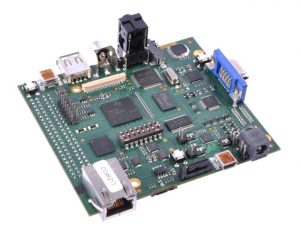Biometrics Functions
“Techniques for Efficient Implementation of Deep Neural Networks,” a Presentation from Stanford
Song Han, graduate student at Stanford, delivers the presentation "Techniques for Efficient Implementation of Deep Neural Networks" at the March 2016 Embedded Vision Alliance Member Meeting. Song presents recent findings on techniques for the efficient implementation of deep neural networks.

Deep Learning Use Cases for Computer Vision (Download)
Six Deep Learning-Enabled Vision Applications in Digital Media, Healthcare, Agriculture, Retail, Manufacturing, and Other Industries The enterprise applications for deep learning have only scratched the surface of their potential applicability and use cases. Because it is data agnostic, deep learning is poised to be used in almost every enterprise vertical… Deep Learning Use Cases for
September 2013 Qualcomm UPLINQ Conference Presentation: “Accelerating Computer Vision Applications with the Hexagon DSP,” Eric Gregori, BDTI
Eric Gregori, Senior Software Engineer at BDTI, presents the "Accelerating Computer Vision Applications with the Hexagon DSP" tutorial at the September 2013 Qualcomm UPLINQ Conference. Smartphones, tablets and embedded systems increasingly use sophisticated vision algorithms to deliver capabilities like augmented reality and gesture user interfaces. Since vision algorithms are computationally demanding, a key challenge when
December 2012 Embedded Vision Alliance Member Summit Technology Trends Presentation
Embedded Vision Alliance Editor-in-Chief (and BDTI Senior Analyst) Brian Dipert and BDTI Senior Software Engineer Eric Gregori co-deliver an embedded vision application technology trends presentation at the December 2012 Embedded Vision Alliance Member Summit. Brian and Eric discuss embedded vision opportunities in mobile electronics devices. They quantify the market sizes and trends for smartphones and
September 2012 Embedded Vision Summit Presentation: “Introduction to Embedded Vision,” Jeff Bier, Embedded Vision Alliance
Jeff Bier, Founder of the Embedded Vision Alliance and co-founder and president of BDTI, presents the day-opening "Introduction to Embedded Vision" tutorial at the September 2012 Embedded Vision Summit. Topics discussed by Bier in his presentation include a technology overview, application examples, hardware, software and development tool trends, and an overview of the Embedded Vision
September 2012 Embedded Vision Summit Afternoon Keynote: Gary Bradski, OpenCV Foundation
Gary Bradski presents the afternoon keynote at the September 2012 Embedded Vision Summit. Bradski is President and CEO of the OpenCV Foundation and Founder and Chief Technical Officer of Industrial Perception Inc. The "father of OpenCV" (the Open Source Computer Vision Library), Bradski has been the director of its development for more than 14 years,
September 2012 Embedded Vision Summit Morning Keynote: Professor Rosalind Picard, MIT Media Lab
Professor Rosalind Picard presents the morning keynote at the September 2012 Embedded Vision Summit. Professor Picard is the founder and director of the Affective Computing Research Group at the MIT Media Laboratory, co-director of the Things That Think Consortium (the largest industrial sponsorship organization at the lab) and leader of the new and growing Autism

Eye Scanning For Biometrics: Increasingly Unreliable Over Time, And An Image That Mimics
Eye-scanning technology is becoming increasingly pervasive as a biometric technique for individual identification, both in Hollywood ("Minority Report" and other films) and in real-life (an India case study that I wrote about last September, for example, or its use by NATO troops in Afghanistan). The generic term actually encompasses two different pattern-recognition implementations: Retinal scans,

TI And Biometrics: A DSP Development Kit Purports To Make Implementation A Breeze
Speaking of Texas Instruments, a few weeks ago the company introduced its new TMS320C6748 DSP Development Kit, which is intended to support real-time video analytics (specifically biometrics, for access control) applications such as fingerprint identification and face detection-and-recognition. From the press release: The C6748 DSP development kit comes pre-loaded with TI's new C6748 SYS/BIOS Software
March 2012 Embedded Vision Alliance Summit Panel Discussion
Jeff Bier, Founder of the Embedded Vision Alliance and co-founder and president of BDTI, moderates the panel discussion "Beyond Kinect; From Research to Revenue," at the March 2012 Embedded Vision Summit. Also participating are Jim Donlon (Project Manager, DARPA), Bruce Kleinman (Corporate Vice President, Platform Marketing, Xilinx), Bruce Flinchbaugh (Fellow and Manager of Vision R&D,

“Dahling, You Look Mahvelous”: Embedded Vision Brings Fashion Into Focus*
Embedded vision, as I've discussed many times before, will only attain high-volume success when it achieves widespread consumer awareness. A company called Bodymetrics, as recently reported in Gizmodo, is doing its part to actualize that aspiration. First, you slip into the company's scanning booth (which is reminiscent of a clothing try-on room), currently installed at

Embedded Vision Gets “Ayes” For Eyes: Empowering the Disenfranchised
My previous writeup, which discussed the emotion-and-other discernment powers of latest-generation embedded vision setups, may have raised privacy-concern red flags in some of your psyches. If that was the case, this piece will hopefully provide a counterbalancing perspective. A wonderful article from the New York Times, which I first read in print and subsequently found

